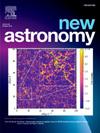深入分析了接触双星GM - Dra的光曲线和第一轨道周期
IF 2.1
4区 物理与天体物理
Q2 ASTRONOMY & ASTROPHYSICS
引用次数: 0
摘要
本文首次利用TESS、SuperWASP、KWS(Ic)、Hipparcos和ASAS-SN卫星的数据,对GM Dra食双星进行了光曲线(LC)分析,并对其轨道周期(OP)进行了详细的研究。从五个不同的数据库中获得的光度数据同时用于分析系统的LC和径向速度(RV)。对GM Dra的LC建模结果显示,目标恒星的质量和半径分别为:M1=0.28±0.01 M⊙,M2=1.34±0.02 M⊙,R1=0.64±0.01 R⊙,R2=1.27±0.02 R⊙。根据TESS和SuperWASP的观测结果,共计算了108次日食次数。这些ETs对于确定OP变化具有重要意义。在长期观测的基础上,对青藏高原的OP进行了分析,结果表明,青藏高原的OP以每年0.051 s的速度递减。周期变化的正弦变化也被确定,这可能归因于潜在的第三个物体或磁活动的存在。这些发现对进化状态(系统在赫茨普龙-罗素(HR)图和logMtot中的位置)提供了重要的见解。讨论了GM - Dra的-logJ图和二元体系的动力学。本文章由计算机程序翻译,如有差异,请以英文原文为准。
In-depth analysis of the light curve and first orbital period of contact binary GM Dra
This study presents the light curve (LC) analysis of the GM Dra eclipsing binary (using data from TESS, SuperWASP, KWS(), Hipparcos, and ASAS-SN), along with a detailed investigation of its orbital period (OP) for the first time. Photometric data obtained from five different databases were used to simultaneously analyze the system’s LC and radial velocity (RV). The LC modeling results for GM Dra reveal the object stars’ masses and radii as follows: M, M, R, and R. A total of 108 eclipse times (ETs) were calculated on the basis of TESS and SuperWASP observations. These ETs are of great significance in determining the OP change. The OP of the GM Dra has been analyzed based on long-term observations, revealing that the OP of GM Dra is decreasing by 0.051 s per year. A sinusoidal variation in the period change was also identified, which may be attributed to the presence of a potential third object or magnetic activity. These findings provide significant insights into the evolutionary status (the positions of the system in the Hertzsprung–Russell (HR) diagram and logM–logJ diagram were discussed) of GM Dra and the dynamics of the binary system.
求助全文
通过发布文献求助,成功后即可免费获取论文全文。
去求助
来源期刊

New Astronomy
地学天文-天文与天体物理
CiteScore
4.00
自引率
10.00%
发文量
109
审稿时长
13.6 weeks
期刊介绍:
New Astronomy publishes articles in all fields of astronomy and astrophysics, with a particular focus on computational astronomy: mathematical and astronomy techniques and methodology, simulations, modelling and numerical results and computational techniques in instrumentation.
New Astronomy includes full length research articles and review articles. The journal covers solar, stellar, galactic and extragalactic astronomy and astrophysics. It reports on original research in all wavelength bands, ranging from radio to gamma-ray.
 求助内容:
求助内容: 应助结果提醒方式:
应助结果提醒方式:


